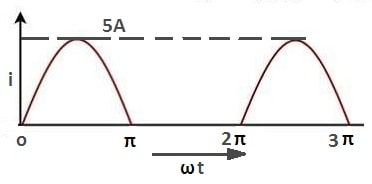1. The current through a resistor has a waveform as shown in Figure given below. The reading shown by a moving coil ammeter will be ……….amperes.
(a) 5/√2
(b) 2.5/√2
(c) 5/π
(d) 0
Answer: (c) 5/π
2. The RMS value of the voltage u(t) = 3 + 4 cos (3t) is
(a) √17
(b) 5 V
(c) 7 V
(d) (3 + 2√2) V
Answer: (a) √17
3. If two sinusoidal of the same frequency but of different amplitudes and phase difference are added, the resultant is a
(a) sinusoidal of the same frequency.
(b) sinusoidal of double the original frequency.
(c) sinusoidal of half the original frequency.
(d) non-sinusoidal.
Answer: (a) sinusoidal of the same frequency.
4. In a purely resistive circuit, the average power Pav is ……….the peak power Pmax
(a) double
(b) one-half of
(c) one-fourth
(d) equal to
Answer: (b) one-half of
5. Pure inductive circuit
(a) consumes some power on average.
(b) does not consume power.
(c) takes power from the line during some part of cycle and then returns back during other part of cycle.
Answer: (c) takes power from the line during some part of cycle and then returns back during other part of cycle.
6. A 10 mH inductor carries a sinusoidal current of 1 A RMS at a frequency of 50 Hz. The average power dissipated by the inductor is
(a) 0 W
(b) 0.25 W
(c) 0.5 W
(d) 1 W
Answer: (a) 0 W
7. A pure capacitance connected across 50 Hz, 230 V supply consumes 0.04 W. This consumption is attributed to
(a) ohmic loss due to ohmic resistance of plates.
(b) loss of energy in dielectric.
(c) capacitive reactance in ohms.
(d) both (a) and (b).
Answer: (d) both (a) and (b).
8. A circuit component that opposes the change in circuit voltage is
(a) resistance
(b) capacitance
(c) inductance
(d) all of the above
Answer: (b) capacitance
9. The reactance offered by a capacitor to AC of frequency 50 Hz is 10 Ω. If the frequency is increased to 100 Hz, reactance becomes
(a) 20Ω
(b) 5Ω
(c) 2.5Ω
(d) 40Ω
Answer: (b) 5Ω
10. The power factor of a practical inductor is
(a) unity
(b) zero
(c) lagging
(d) Leading
Answer: (b) zero
11. The power consumed in an inductive circuit will be
(a) VI cosɸ
(b) VI sinɸ
(c) VI
(d) None of these
Answer: VI cosɸ
12. Transient disturbance occurs in a circuit whenever it is
(a) shorted.
(b) suddenly connected or disconnected from the supply.
(c) subjected to changing voltage.
(d) all of the above.
Answer: (d) all of the above.
13. In electrical circuits, transient currents are associated with
(a) resistors.
(b) inductors.
(c) capacitors.
(d) both (b) and (c)
Answer: (d) both (b) and (c)
14. A component that opposes the change in circuit current is
(a) resistance.
(b) capacitance.
(c) inductance.
(d) conductance.
Answer: (c) inductance.
15. For a DC voltage an inductor
(a) is virtually a short circuit.
(b) is and open circuit.
(c) depends on polarity.
(d) depends on voltage value.
Answer: (a) is virtually a short circuit.
16. Inductance affects the flow of direct current at the time of
(a) turning off.
(b) turning on.
(c) turning on and off.
(d) none of the above.
Answer: (c) turning on and off.
17. An R-C series circuit is excited by a DC source. After it switching on
(a) the voltages across resistance and capacitance are equal.
(b) the voltage across resistance is zero.
(c) the voltage across capacitance is zero.
(d) the sum of the voltage across resistance and capacitance is always equal to the supply voltage.
Answer: (d) the sum of the voltage across resistance and capacitance is always equal to the supply voltage.
Basic Electrical Quiz Questions with Answers
- Basic Electrical Engineering MCQ
- MCQ on Lead Acid Battery
- MCQ Questions on Electromagnetism
- Series Parallel RLC Circuit MCQ
- Three Phase System Question and Answers
- Basic Electrical Quiz Questions With Answers
© www.yourelectricalguide.com/ basic electrical quiz questions with answers.
